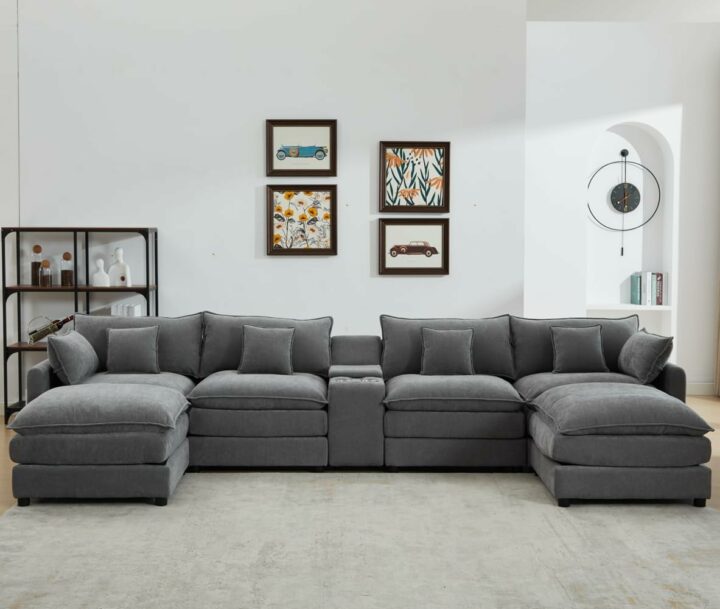Table of Contents
Warm Minimalism Décor: Creating Cozy Spaces with Simple Elegance
Warm minimalism décor combines simplicity with warmth, creating inviting spaces that feel both stylish and cozy. This design trend emphasizes natural materials and soft shapes, making our homes feel more comfortable while still looking clean and organized. By focusing on rounded forms and earthy colors, we can personalize our spaces while keeping things minimal.

As we explore the world of warm minimalism, we’ll discover how to balance functionality with a sense of comfort. From selecting the right furniture to adding those personal touches, we can transform our living spaces into serene sanctuaries. Getting this look is all about creating environments that encourage relaxation and joy.
We’re excited to share tips and ideas for making warm minimalism work in our homes. Whether we’re starting from scratch or refreshing our current style, this approach can help us embrace tranquility and beauty in our everyday lives.
Key Takeaways
- Warm minimalism blends simplicity with comfort to enhance our living spaces.
- Incorporating natural materials and soft edges creates a cozy atmosphere.
- Personal touches can easily transform a minimalistic space into a welcoming home.
The Essence of Warm Minimalism
Warm minimalism blends the simplicity of minimalist design with cozy elements that create inviting spaces. It’s a trend that resonates with many, focusing on comfort while maintaining a clean and streamlined look.
Defining the Aesthetic
Warm minimalism emphasizes both simplicity and warmth. We can achieve this look using natural materials like wood and stone, as well as soft textiles that invite touch.
Key features include:
- Natural Color Palettes: Soft, muted tones bring a calming effect.
- Functional Design: Every piece serves a purpose, reducing clutter while adding charm.
- Layered Textures: Different materials add depth without overwhelming the eye.
This approach creates spaces where we can relax and feel at home, all while keeping a chic and stylish atmosphere.
History and Influences
The roots of warm minimalism trace back to traditional minimalist designs, but it has evolved over the years. Influences come from various global styles.
Scandinavian design is a significant contributor, known for its functional yet cozy aesthetics. Japanese design also plays a role, focusing on simplicity and a connection to nature.
As we look around, we see this style merging with other trends. From California’s desert landscapes to organic modern influences, warm minimalism is all about finding balance, allowing us to enjoy beauty without excess.
Elements of Warm Minimalism
In warm minimalism, we focus on creating inviting spaces that feel cozy and stylish. To achieve this, we pay close attention to our choices in color palette, materials, and furniture selection.
Color Palette
When selecting a color palette, we often choose warm and earthy tones. Colors like soft beige, muted greens, and warm browns create a relaxing vibe. We can also mix in light pastels for a subtle pop of color.
Using a monochromatic scheme is another great option. By varying shades of a single color, we can add depth while keeping the look simple. These colors help to foster a calm, peaceful environment.
Materials and Textures
In warm minimalism, materials play a key role. We like to incorporate natural elements such as wood, stone, and textiles that invite touch.
Layering different textures enhances comfort. Think about combining a soft wool throw with a smooth leather sofa. We can also use natural fibers like jute or seagrass for rugs. These choices bring warmth and depth to our space.
Using materials that age gracefully, like reclaimed wood, adds character. This is important because it reflects our appreciation for authenticity and helps create a lived-in feel.
Furniture Selection
Furniture selection in warm minimalism leans towards contemporary pieces with clean lines. We often choose items that have organic shapes or rounded edges. This balance creates a welcoming atmosphere while maintaining a minimalist aesthetic.
Opting for multifunctional furniture is another great idea. For instance, a coffee table with storage can keep our space tidy. We also look for furniture made from natural materials that align with our color palette.
We can mix different furniture styles, pairing minimalist designs with cozy accents. Pieces that serve as statement furniture can add personality without overwhelming the space, keeping it both stylish and inviting.
Creating the Space

To craft a warm minimalism décor, we focus on layout and flow, lighting, and integrating nature. These elements help create a cozy atmosphere while keeping things simple and uncluttered.
Layout and Flow
Creating a functional layout is key. We want our space to have a natural flow, making it easy to move around. Start by arranging furniture to encourage conversation.
Using soft shapes in our furniture can also help. Rounded edges are more inviting than sharp ones.
Consider open spaces that allow light to travel. This openness can make a room feel larger and more comfortable.
We can also use area rugs to define different zones in a room. They add warmth without overwhelming the design.
Lighting
Lighting plays a huge role in setting the mood. We should aim for a mix of natural and soft artificial light.
Large windows are excellent for letting in sunlight during the day. For evening, we can choose warm-colored bulbs for a cozy glow.
Incorporating various light sources is also beneficial. Think floor lamps, table lamps, and dimmable ceiling lights.
Layering our lighting options creates depth and makes the space feel more inviting.
Don’t forget decorative fixtures that enhance the overall design—those details really pull everything together.
Integrating Nature
Bringing elements of nature indoors enhances the warm and inviting feel. Plants are a great way to add life and color.
We can choose low-maintenance varieties, such as snake plants or pothos, which fit nicely in minimalist décor.
Natural materials also work wonders—think wooden furniture or stone accents.
Textiles made from organic fibers can add texture and warmth. A soft wool or cotton blanket on a chair can make it feel more inviting.
By incorporating these natural elements, we create a stronger connection between our home and the outdoors.
Accents and Details
In warm minimalism décor, accents and details play a crucial role in creating a comfortable yet stylish atmosphere. By carefully choosing artwork, decorations, and textiles, we can enhance the simple beauty of our spaces.
Artwork and Decorations
When it comes to artwork, we should focus on pieces that evoke warmth and serenity. Think about using soft, earthy colors like terracotta or muted greens. These colors blend nicely with neutral backgrounds.
We can also explore different styles, such as abstract art or photography, to create visual interest. Choosing a few statement pieces is better than overcrowding the walls. This way, each piece stands out and contributes to the overall feeling of the room.
Natural materials can elevate any space. Items like wooden sculptures or ceramic vases add texture and warmth. We can also mix in plants for a touch of nature that livens up our décor.
Textiles and Fabrics
Textiles play a big role in warm minimalism. We can use soft fabrics like cotton, linen, or wool to create a cozy vibe. Choosing a color palette that complements our overall design helps keep things cohesive.
Layering is key. Adding throws or cushions in muted tones can make our spaces feel inviting. We might consider textures too; chunky knit blankets or smooth linen curtains can provide contrast and depth.
Rugs are another essential aspect. A large, comfortable rug can unite the room and add warmth underfoot. We should choose patterns that are subtle and not too busy to maintain the minimalist look.
In short, by focusing on these accents and details, we can create a warm and inviting environment that still embraces simplicity.
Maintaining Warm Minimalism
Keeping our warm minimalist décor looking its best is all about regular upkeep and making thoughtful seasonal changes. It’s essential to create a cozy environment while ensuring everything stays fresh and inviting.
Cleaning and Upkeep
To maintain our warm minimalist space, regular cleaning is key. We should focus on surfaces that gather dust but remember to keep it simple. A quick weekly dusting helps keep our spaces clean without overwhelming us.
Key Tips:
- Use a soft microfiber cloth for surfaces.
- Avoid heavy cleaners; natural options work wonders.
- Regularly wash soft textiles like throws or pillows.
Organizing our items also plays a huge role. We can use storage solutions that blend in with our décor, helping us keep our space clutter-free. Baskets, bins, and stylish shelving can help us keep things tidy and visually appealing.
Seasonal Adjustments
As the seasons change, so can our warm minimalism. We can embrace cozy textures and colors based on the time of year. For example, in fall and winter, introducing richer fabrics like wool or heavier blankets makes our space feel inviting.
Adjustments to Consider:
- Swap light summer décor for autumnal hues.
- Incorporate seasonal plants for a fresh touch.
- Change out artwork or décor pieces to reflect the seasons.
These small changes help create a space that feels warm and lived-in. In spring and summer, we can bring in lighter colors and airy textiles to keep our environment feeling fresh.
Frequently Asked Questions
Let’s dive into some common questions about warm minimalism. We’ll cover tips for different rooms, color choices, and how to keep things cozy while maintaining a minimalist vibe.
How can you create a warm and inviting minimalist living room?
To make our living room warm and inviting, we can focus on using natural materials. Think wood furniture, soft textiles, and warm lighting. Adding a few personal items, like family photos or art, can also help create a welcoming space.
What are some warm minimalist bedroom design tips?
For our bedroom, we should stick to a neutral color palette and choose soft, comfortable bedding. Incorporating rounded shapes in our furniture can add warmth. We can also use layered lighting to set a cozy mood at night.
Which colors work best for a warm minimalist palette?
Warm minimalism benefits from a neutral base, like creams, beige, and soft browns. We can add touches of warm colors, such as terracotta or muted yellows, to create a more inviting atmosphere without overwhelming the space.
How do you maintain a cozy feel in a minimalist kitchen?
In the kitchen, we can choose natural materials for cabinets and countertops, like wood or stone. Keeping the space clutter-free is key, and we can use decorative jars or plants to add warmth without sacrificing the minimalist look.
What’s the difference between warm minimalism and Scandinavian minimalism?
While both styles embrace simplicity, warm minimalism focuses more on cozy, inviting elements. Scandinavian minimalism often leans towards cooler colors and a more stark, functional aesthetic. We can mix elements from both styles to suit our preferences.
Can you share some ideas for a warm minimalist bathroom?
In our bathroom, we can use soft lighting and natural materials, like wood accents and stone tiles. Keeping the decor simple is important, and we might add a few plants for a touch of freshness and warmth. A warm color scheme can make the space feel more inviting.

